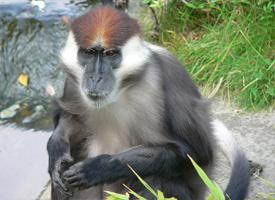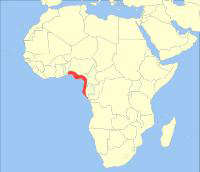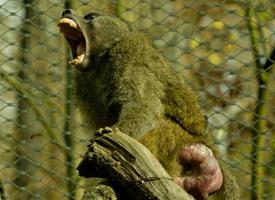
Súlyok és méretek
| Hossz | 50-tól 60-ig cm |
|---|---|
| Súly | 10 kg |
| Farokhossz | 60-tól 75-ig cm |
Biológiai adatok
| Vemhességi idő | 170 dní |
|---|---|
| Utódok száma | 1 |
Veszélyeztetettség
| Veszélyeztetett |
Állatleírás
The Collared Mangabey, scientifically known as Cercocebus torquatus, is a fascinating and unique species of primate that belongs to the family Cercopithecidae. This captivating animal is primarily found in the dense forests and swampy areas of West Africa, stretching from Ghana to Gabon, showcasing its adaptability to various types of forested environments. The species is characterized by its distinctive appearance and intriguing behaviors, making it a subject of interest among wildlife enthusiasts and researchers alike.Physical Description:
The Collared Mangabey is a medium-sized primate with a robust and agile body, adapted for a life both in the trees (arboreal) and on the ground (terrestrial). One of the most striking features of this species is its long, shaggy coat, which is predominantly grey or dark brown, with a slightly paler underbelly. The fur around its neck is lighter in color, giving the appearance of a collar, from which its common name is derived. Its face is dark-skinned, framed by a mane of long hair, and features expressive, forward-facing eyes that are vital for its depth perception in the dense forest canopy. The animal has a long tail, which is not prehensile but aids in balance while moving through the trees.
Adult Collared Mangabeys typically weigh between 7 to 13 kilograms, with males being larger and more robust than females. Their powerful limbs are equipped with strong, dexterous hands and feet, enabling them to grasp branches securely and forage efficiently for food.
Behavior and Ecology:
Collared Mangabeys are diurnal, meaning they are active during the day. They live in large, social groups known as troops, which can comprise anywhere from a few individuals to over a hundred, depending on the habitat's carrying capacity and the availability of resources. These troops are hierarchical, with a dominant male often leading the group. Communication within the troop is vital and is facilitated through a complex system of vocalizations, facial expressions, and body postures.
The diet of the Collared Mangabey is omnivorous but primarily consists of fruits, seeds, insects, and occasionally small vertebrates. This varied diet reflects the animal's adaptability and its role as a significant seed disperser in its ecosystem, contributing to the health and regeneration of the forest.
Conservation Status:
The Collared Mangabey is classified as Vulnerable by the International Union for Conservation of Nature (IUCN), with habitat loss due to deforestation, hunting for bushmeat, and the pet trade being the primary threats to its survival. The expansion of agricultural land and human settlements into forested areas reduces the available habitat for this species, leading to fragmented populations that are more vulnerable to extinction.
Conservation efforts for the Collared Mangabey include habitat protection and restoration, anti-poaching measures, and education programs aimed at reducing bushmeat hunting. Research into the species' ecology and behavior is also crucial for developing effective conservation strategies that can ensure the survival of this unique primate.
In conclusion, the Collared Mangabey is a remarkable and important species within its ecosystem. Its survival is closely tied to the preservation of West Africa's forests, highlighting the need for concerted conservation efforts to protect these environments and their inhabitants. By understanding more about the Collared Mangabey and the challenges it faces, we can work towards a future where this captivating primate thrives in the wild.
Előfordulási térkép

Hasonló állatok
Új állatfotók
Top 10 állat
- Dolphin gull (Leucophaeus scoresbii)
- Japanese macaque (Macaca fuscata)
- Stone loach (Barbatula barbatula)
- Russian tortoise (Testudo horsfieldii)
- Galápagos tortoise (Geochelone nigra complex)
- Greek tortoise (Testudo graeca)
- Diana monkey (Cercopithecus diana)
- Common flying dragon (Draco volans)
- Moustached guenon (Cercopithecus cephus)
- Galápagos penguin (Spheniscus mendiculus)


